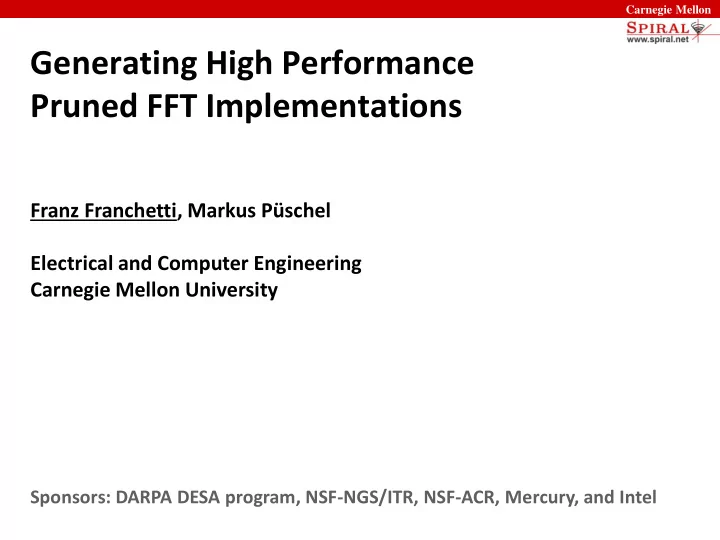

Carnegie Mellon Generating High Performance Pruned FFT Implementations Franz Franchetti, Markus Püschel Electrical and Computer Engineering Carnegie Mellon University Sponsors: DARPA DESA program, NSF-NGS/ITR, NSF-ACR, Mercury, and Intel
Carnegie Mellon The Idea: Pruned FFT Input pruning E.g., center ¾ inputs are known to be zero Output pruning E.g., only the low ½ frequencies are used Simultaneous input & output pruning Some inputs known zeros and some outputs discarded Pruned FFT FFT Pruned DFT: 5% – 30% operations reduction in application settings
Carnegie Mellon The Problem Discrete Fourier Transform (single precision): 2 x Core2 Extreme 3 GHz 26 24 22 20 18 16 best code 14 (Spiral generated) 30x 12 Same operations count 10 8 6 4 Numerical Recipes 2 0 16 32 64 128 256 512 1024 2048 4096 8192 16384 32768 65536 131072262144 Problem size Can we turn 5% – 30% operations savings into speed-up ?
Carnegie Mellon Organization Spiral overview Pruned FFT Results Concluding remarks
Carnegie Mellon Spiral Library generator for linear transforms (DFT, DCT, DWT, filters, ….) and recently more … Wide range of platforms supported: scalar, fixed point, vector, parallel, Verilog, GPU Research Goal: “Teach” computers to write fast libraries Complete automation of implementation and optimization Conquer the “high” algorithm level for automation When a new platform comes out: Regenerate a retuned library When a new platform paradigm comes out (e.g., CPU+GPU): Update the tool rather than rewriting the library Intel uses Spiral to generate parts of their MKL and IPP libraries
Carnegie Mellon How Spiral Works Problem specification (transform) controls Spiral: Algorithm Generation Complete automation of Algorithm Optimization the implementation and algorithm optimization task controls Search Implementation Basic idea: Code Optimization Declarative representation of algorithms C code Compilation Rewriting systems to performance generate and optimize Compiler Optimizations algorithms Spiral Fast executable
Carnegie Mellon Fast Algorithms, Example: 4-point FFT Fast algorithms = matrix factorizations 12 adds 4 adds 1 mult 4 adds 4 mults Kronecker product Permutation Fourier transform Identity SPL = mathematical, declarative specification SPL formula can be translated into program
Carnegie Mellon Transforms and Breakdown Rules “Teaches” Spiral about existing algorithm knowledge (~200 journal papers) Base case rules Goal: Derive Cooley-Tukey Pruned FFT rule
Carnegie Mellon Organization Spiral overview Pruned FFT Results Concluding remarks
Carnegie Mellon Data Sparseness: Block Sequences Sequence Block sequence Example - 2 =
Carnegie Mellon Zero-Padding: Scatter Matrix Definition Example S σ . =
Carnegie Mellon Cooley-Tukey Pruned FFT Rule Recursive input pruning rule Base case Similar rule for output pruning and simultaneous pruning Pruned FFT FFT
Carnegie Mellon Derivation: Cooley-Tukey Pruned FFT Rule Cooley-Tukey FFT rule + Kronecker product identities
Carnegie Mellon Organization Spiral overview Pruned FFT Results Concluding remarks
Carnegie Mellon DFT: Spiral vs. FFTW and MKL (2 cores, 4-way SSE) performance [Gflop/s], single-precision, Intel C++ 10.1, SSSE3, Windows XP 32-bit 20 18 16 14 12 10 8 Spiral DFT SSE+SMP Spiral DFT SSE 6 Intel MKL 9.0 FFTW DFT 4 Numerical Recipes in C 2 0 256 512 768 1,024 2,048 3,072 4,096 5,120 6,144 7,168 8,192 9,216 10,240 11,264 12,288 13,312 14,336 15,360 16,384 input size Spiral-generated DFT is good baseline
Carnegie Mellon Spiral: Pruned DFT vs. DFT (4-way SSE) performance [Gflop/s], single-precision, Intel C++ 10.1, SSSE3, Windows XP 32-bit 25 20 15 10 Pruned DFT (first 1/16 non-zero) Pruned DFT (center 7/8 zero) Pruned DFT (center 1/4 non-zero) 5 Pruned DFT (second half zero) Spiral DFT 0 256 512 768 1,024 2,048 3,072 4,096 5,120 6,144 7,168 8,192 9,216 10,240 11,264 12,288 13,312 14,336 15,360 16,384 input size FFT input pruning: speed-up for sequential vector DFT
Carnegie Mellon Spiral: Pruned DFT vs. DFT (2 cores, 4-way SSE) performance [Gflop/s], single-precision, Intel C++ 10.1, SSSE3, Windows XP 32-bit 25 20 15 10 Pruned DFT (first 1/16 non-zero) Pruned DFT (center 7/8 zero) Pruned DFT (center 1/4 non-zero) 5 Pruned DFT (second half zero) Spiral DFT 0 256 512 768 1,024 2,048 3,072 4,096 5,120 6,144 7,168 8,192 9,216 10,240 11,264 12,288 13,312 14,336 15,360 16,384 input size FFT input pruning: speed-up for parallel vector DFT
Carnegie Mellon Spiral: I/O Pruned DFT vs. DFT (4-way SSE) performance [Gflop/s], single-precision, Intel C++ 10.1, SSSE3, Windows XP 32-bit 25 20 15 10 I/O Pruned DFT (output: first 1/16 non-zero, input: center 3/4 zero) 5 I/O Pruned DFT (output: center 7/8 zero, input: first 1/4 non-zero) Spiral DFT 0 256 512 768 1,024 2,048 3,072 4,096 5,120 6,144 7,168 8,192 9,216 10,240 11,264 12,288 13,312 14,336 15,360 16,384 input size I/O pruning: better speed-up than input pruning only
Carnegie Mellon Organization Spiral overview Pruned FFT Results Concluding remarks
Carnegie Mellon Summary Spiral’s goal: “Teach” computers to write fast libraries From problem specification to very fast code---automatically (click button) Optimization at a high level of abstraction Memory hierarchy, vector SIMD, multicore ,… The generated programs are very fast Often better than human-written code Pruned FFT: lower operations count translates into speed-up up to 30% over best vector SIMD and multicore code for input pruning
Recommend
More recommend